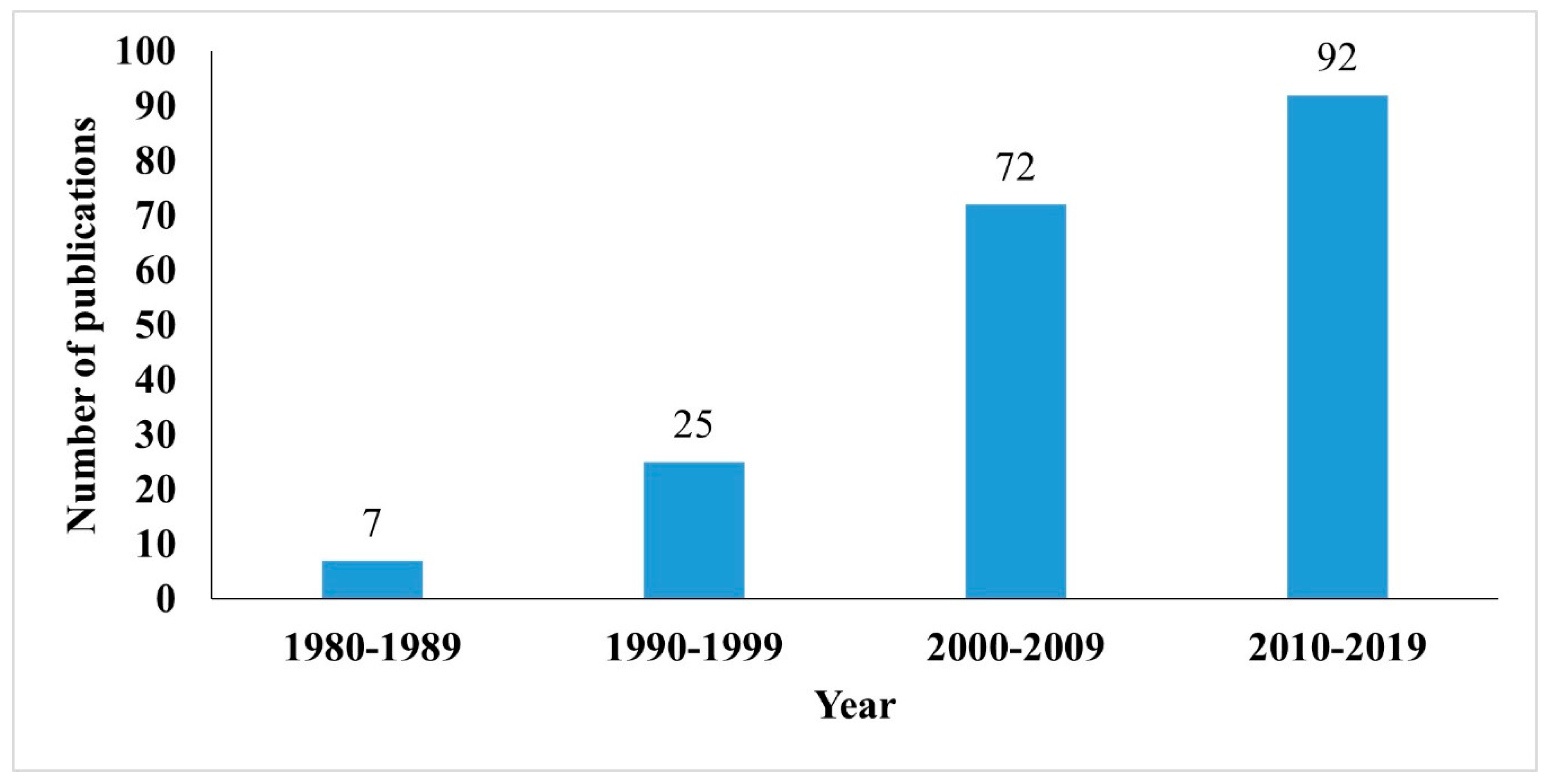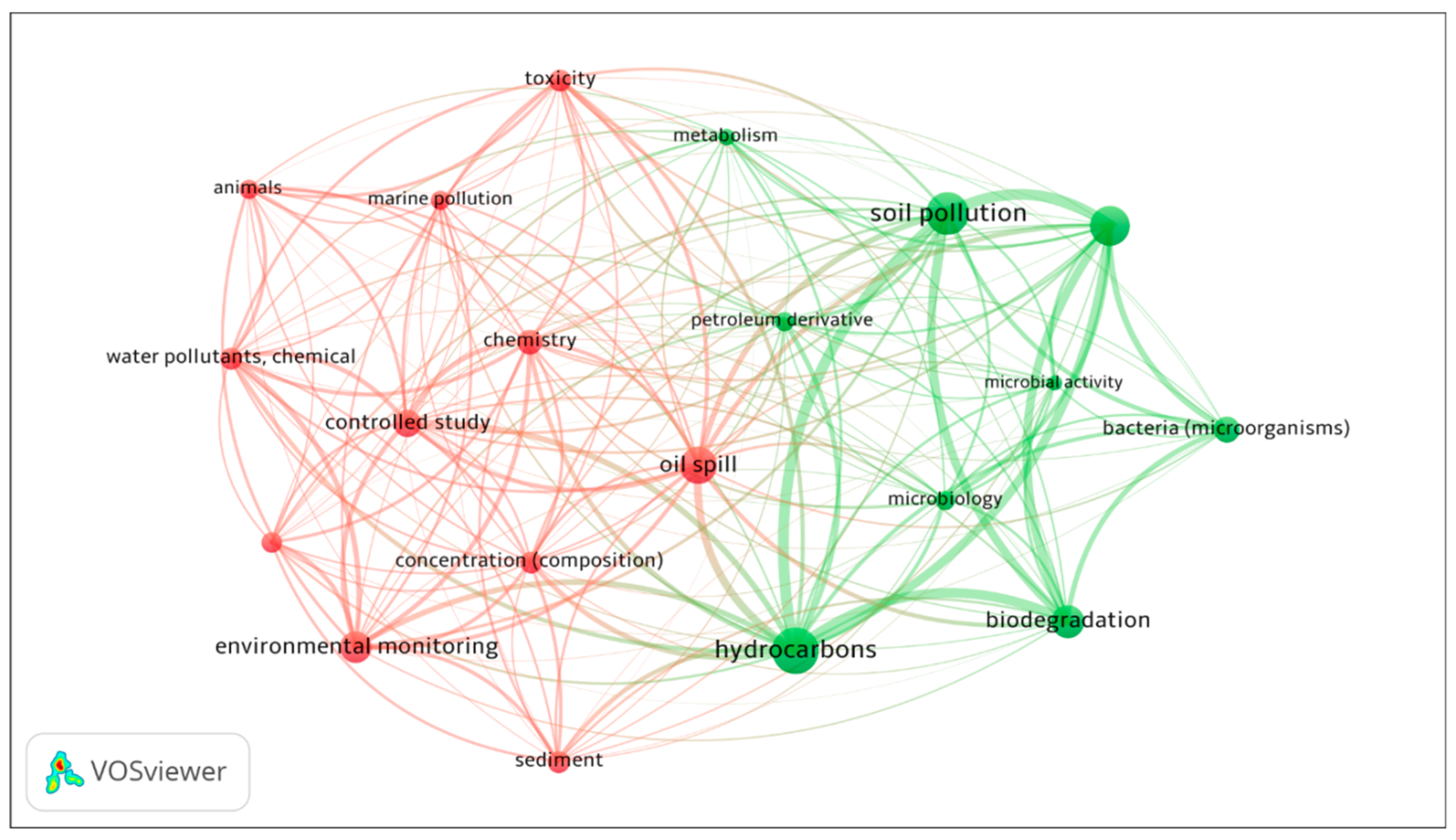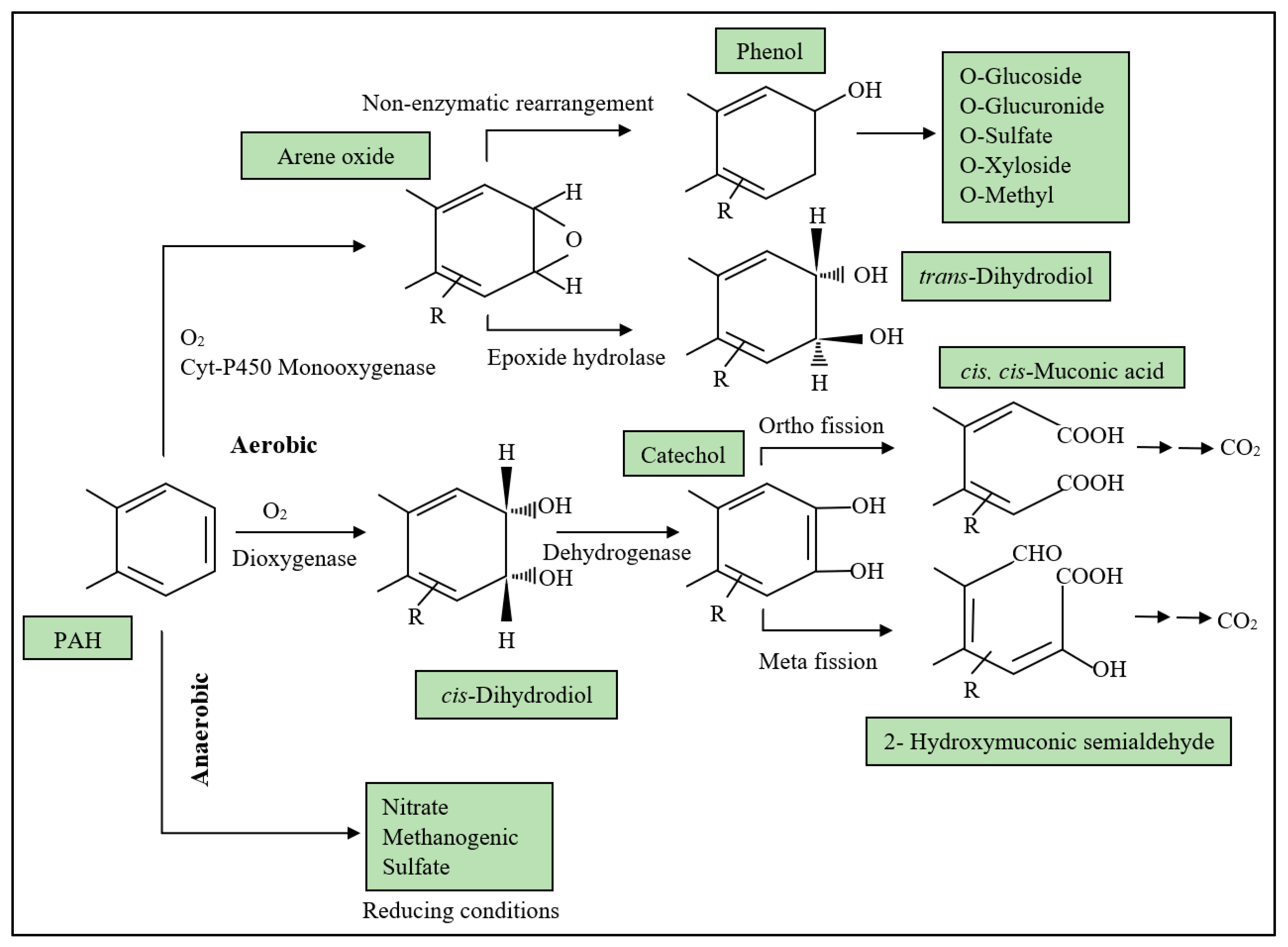Bibliometric Analysis of Research on Diesel Pollution in Antarctica and a Review on Remediation Techniques
Abstract
:1. Introduction
2. Review Methodology
3. Diesel Pollution: History and Causes
4. Research Focus and Trend
5. Remediation Techniques: Physical, Chemical and Biological Approaches
6. Bioremediation: Feasibility and Limits
7. Bioremediation: Microbial Pathway
8. Phytoremediation
9. Conclusions
Author Contributions
Funding
Acknowledgments
Conflicts of Interest
References
- Cripps, G. Natural and anthropogenic hydrocarbons in the Antarctic marine environment. Mar. Pollut. Bull. 1992, 25, 266–273. [Google Scholar] [CrossRef]
- Tengku-Mazuki, T.A.; Subramaniam, K.; Zakaria, N.N.; Convey, P.; Khalil, K.A.; Lee, G.L.Y.; Zulkharnain, A.; Shaharuddin, N.A.; Ahmad, S.A. Optimization of phenol degradation by Antarctic bacterium Rhodococcus sp. Antarct. Sci. 2020, 32, 486–495. [Google Scholar] [CrossRef]
- Raymond, T.; King, C.; Stark, J.; Snape, I. Oil Pollution in Antarctica. In Oil Spill Science and Technology, 2nd ed.; Fingas, M., Ed.; Gulf Professional Publishing: Houston, TX, USA, 2017; pp. 759–803. ISBN 978-0-120809413-6. [Google Scholar]
- Subramaniam, K.; Ahmad, S.A.; Shaharuddin, N.A. Mini review on phenol biodegradation in Antarctica using native microorganisms. Asia Pac. J. Mol. Biol. Biotechnol. 2020, 28, 77–89. [Google Scholar] [CrossRef]
- Abdulrasheed, M.; Zakaria, N.N.; Roslee, A.F.A.; Shukor, M.Y.; Zulkharnain, A.; Napis, S.; Convey, P.; Alias, S.A.; Gonzalez-Rocha, G.; Ahmad, S.A. Biodegradation of diesel oil by cold-adapted bacterial strains of Arthrobacter spp. from Antarctica. Antarct. Sci. 2020, 1–13. [Google Scholar] [CrossRef]
- Aria, M.; Cuccurullo, C. bibliometrix: An R-tool for comprehensive science mapping analysis. J. Inf. 2017, 11, 959–975. [Google Scholar] [CrossRef]
- Van Eck, N.J.; Waltman, L. Software survey: VOSviewer, a computer program for bibliometric mapping. Scientometrics 2010, 84, 523–538. [Google Scholar] [CrossRef] [PubMed] [Green Version]
- Tin, T.; Fleming, Z.L.; Hughes, K.A.; Ainley, D.G.; Convey, P.; Moreno, C.A.; Pfeiffer, S.; Scott, J.; Snape, I. Impacts of local human activities on the Antarctic environment. Antarct. Sci. 2009, 21, 3–33. [Google Scholar] [CrossRef] [Green Version]
- Antarctic Treaty Consultative Parties. ANNEX III to the Protocol on Environmental Protection to the Antarctic Treaty; Her Majesty’s Stationery Office: London, UK, 1991.
- Brown, D.M.; Bonte, M.; Gill, R.; Dawick, J.; Boogaard, P.J. Heavy hydrocarbon fate and transport in the environment. Q. J. Eng. Geol. Hydrogeol. 2017, 50, 333–346. [Google Scholar] [CrossRef]
- Sweet, S.T.; Kennicutt, M.C.; Klein, A.G. The grounding of the Bahía Paraíso, Arthur Harbor, Antarctica. In Handbook of Oil Spill Science and Technology; Fingas, M., Ed.; John Wiley & Sons, Inc.: Hoboken, NJ, USA, 2015; pp. 547–556. ISBN 978-0-470-45551-7. [Google Scholar]
- BBC News. Aurora Autsralis: Antarctica Icebreaker Passengers Rescued. Autsralia BBC News, 26 February 2016. [Google Scholar]
- Woehler, E.J.; Johnstone, G.W. Status and Conservation of the Seabirds of the Australian Antarctic Territory. In Seabird Status and Conservation: A Supplement; Croxall, J.P., Ed.; International Council for Bird Preservation: Cambridge, UK, 1991; pp. 279–308. ISBN 9780946888191. [Google Scholar]
- Smith, S.D.A.; Simpson, R. Effects of the ’Nella Dan’ oil spill on the fauna of Durvillaea antarctica holdfasts. Mar. Ecol. Prog. Ser. 1995, 121, 73–89. [Google Scholar] [CrossRef] [Green Version]
- Penhale, P.; Coosen, J.; Marshoff, E.R. The Bahia Paraiso: A Case Study in Environmental Impact, Remediation and Monitoring. In Antarctic Communities: Species, Structure and Survival; Battaglia, B., Valencia, J., Walton, D.W.H., Eds.; Cambridge University Press: Cambridge, UK, 1997; pp. 444–457. [Google Scholar]
- Ruoppolo, V.; Woehler, E.J.; Morgan, K.; Clumpner, C.J. Wildlife and oil in the Antarctic: A recipe for cold disaster. Polar Rec. 2012, 49, 97–109. [Google Scholar] [CrossRef]
- Liggett, D.; McIntosh, A.; Thompson, A.; Gilbert, N.; Storey, B. From frozen continent to tourism hotspot? Five decades of Antarctic tourism development and management, and a glimpse into the future. Tour. Manag. 2011, 32, 357–366. [Google Scholar] [CrossRef]
- Kesselly, B. Report of Investigation in the Matter of Sinking of Passenger Vessel EXPLORER (O.N. 8495) 23 November 2007 in the Bransfield Strait Near the South Shetland Islands; The Bureau of Maritime Affairs: Monrovia, Liberia, 2009.
- Szopińska, M.; Szumińska, D.; Bialik, R.J.; Dymerski, T.; Rosenberg, E.; Polkowska, Ż. Determination of polycyclic aromatic hydrocarbons (PAHs) and other organic pollutants in freshwaters on the western shore of Admiralty Bay (King George Island, Maritime Antarctica). Environ. Sci. Pollut. Res. 2019, 26, 18143–18161. [Google Scholar] [CrossRef] [PubMed] [Green Version]
- Bennett, J. Advanced fuel additives for modern internal combustion engines. In Alternative Fuels and Advanced Vehicle Technologies for Improved Environmental Performance; Folkson, R., Ed.; Woodhead Publishing: Cambridge, UK, 2014; pp. 165–194. ISBN 9780857095220. [Google Scholar]
- Macoustra, G.K.; King, C.K.; Wasley, J.; Robinson, S.A.; Jolley, D.F. Impact of hydrocarbons from a diesel fuel on the germination and early growth of subantarctic plants. Environ. Sci. Process. Impacts 2015, 17, 1238–1248. [Google Scholar] [CrossRef] [PubMed] [Green Version]
- Brown, K.E.; King, C.K.; Kotzakoulakis, K.; George, S.C.; Harrison, P.L. Assessing fuel spill risks in polar waters: Temporal dynamics and behaviour of hydrocarbons from Antarctic diesel, marine gas oil and residual fuel oil. Mar. Pollut. Bull. 2016, 110, 343–353. [Google Scholar] [CrossRef]
- Singer, M.; Aurand, D.; Bragin, G.; Clark, J.; Coelho, G.; Sowby, M.; Tjeerdema, R. Standardization of the Preparation and Quantitation of Water-accommodated Fractions of Petroleum for Toxicity Testing. Mar. Pollut. Bull. 2000, 40, 1007–1016. [Google Scholar] [CrossRef]
- Sirotkin, A.V. Reproductive Effects of Oil-Related Environmental Pollutants. In Encyclopedia of Environmental Health, 2nd ed.; Nrigau, J., Ed.; Elsevier: Amsterdam, The Netherlands, 2018; pp. 493–498. [Google Scholar]
- Abdel-Shafy, H.I.; Mansour, M.S. A review on polycyclic aromatic hydrocarbons: Source, environmental impact, effect on human health and remediation. Egypt. J. Pet. 2016, 25, 107–123. [Google Scholar] [CrossRef] [Green Version]
- McGrath, J.A.; Di Toro, D.M. Validation of the Target Lipid Model for Toxicity Assessment of Residual Petroleum Constituents: Monocyclic and Polycyclic Aromatic Hydrocarbons. Environ. Toxicol. Chem. 2009, 28, 1130–1148. [Google Scholar] [CrossRef]
- Naidoo, K. The Effects of Petroleum Hydrocarbon Contamination on Selected Intertidal Macrophytes and Meiofauna. Ph.D. Thesis, University of KwaZulu-Natal, Durban, South Africa, 2015. [Google Scholar]
- Stark, J.S.; Mohammad, M.; McMinn, A.; Ingels, J. The effects of hydrocarbons on meiofauna in marine sediments in Antarctica. J. Exp. Mar. Biol. Ecol. 2017, 496, 56–73. [Google Scholar] [CrossRef]
- Lewis, C.; Pook, C.; Galloway, T.S. Reproductive toxicity of the water accommodated fraction (WAF) of crude oil in the polychaetes Arenicola marina (L.) and Nereis virens (Sars). Aquat. Toxicol. 2008, 90, 73–81. [Google Scholar] [CrossRef] [Green Version]
- Nydahl, A.C.; King, C.K.; Wasley, J.; Jolley, D.F.; Robinson, S.A. Toxicity of fuel-contaminated soil to Antarctic moss and terrestrial algae. Environ. Toxicol. Chem. 2015, 34, 2004–2012. [Google Scholar] [CrossRef] [Green Version]
- Lu, J. Identification of Forensic Information from Existing Conventional Site-Investigation Data. In Introduction to Environmental Forensics, 3rd ed.; Murphy, B.L., Morrison, R.D., Eds.; Academic Press: Cambridge, MA, USA, 2015; pp. 149–164. ISBN 978-0-12-404696-2. [Google Scholar]
- García-Delgado, C.; Alfaro-Barta, I.; Eymar, E. Combination of biochar amendment and mycoremediation for polycyclic aromatic hydrocarbons immobilization and biodegradation in creosote-contaminated soil. J. Hazard. Mater. 2015, 285, 259–266. [Google Scholar] [CrossRef] [PubMed]
- Tewari, S.; Sirvaiya, A. Oil spill remediation and its regulation. Int. J. Res. Sci. Eng. 2015, 1, 1–7. [Google Scholar]
- Obi, E.O.; Kamgba, F.A.; Obi, D.A. Techniques of Oil Spill Response in the sea. IOSR J. Appl. Phys. 2014, 6, 36–41. [Google Scholar] [CrossRef]
- Rico-Martinez, R.; Snell, T.W.; Shearer, T.L. Synergistic toxicity of Macondo crude oil and dispersant Corexit 9500A® to the Brachionus plicatilis species complex (Rotifera). Environ. Pollut. 2013, 173, 5–10. [Google Scholar] [CrossRef] [PubMed]
- Elarbaoui, S.; Richard, M.; Boufahja, F.; Mahmoudi, E.; Thomas-Guyon, H. Effect of crude oil exposure and dispersant application on meiofauna: An intertidal mesocosm experiment. Environ. Sci. Process. Impacts 2015, 17, 997–1004. [Google Scholar] [CrossRef] [PubMed]
- McWatters, R.; Wilkins, D.; Spedding, T.; Hince, G.; Raymond, B.; Lagerewskij, G.; Terry, D.; Wise, L.; Snape, I. On site remediation of a fuel spill and soil reuse in Antarctica. Sci. Total Environ. 2016, 571, 963–973. [Google Scholar] [CrossRef] [PubMed]
- Álvarez, L.M.M.; Ruberto, L.; Balbo, A.L.; Mac Cormack, W.P. Bioremediation of hydrocarbon-contaminated soils in cold regions: Development of a pre-optimized biostimulation biopile-scale field assay in Antarctica. Sci. Total Environ. 2017, 591, 194–203. [Google Scholar] [CrossRef]
- Ortiz, M.; Bosch, J.; Coclet, C.; Johnson, J.; Lebre, P.; Salawu-Rotimi, A.; Vikram, S.; Makhalanyane, T.P.; Cowan, D.A. Microbial Nitrogen Cycling in Antarctic Soils. Microorganisms 2020, 8, 1442. [Google Scholar] [CrossRef]
- Azubuike, C.C.; Chikere, C.B.; Okpokwasili, G.C. Bioremediation techniques–classification based on site of application: Principles, advantages, limitations and prospects. World J. Microbiol. Biotechnol. 2016, 32, 1–18. [Google Scholar] [CrossRef] [Green Version]
- Whelan, M.; Coulon, F.; Hince, G.; Rayner, J.; McWatters, R.; Spedding, T.; Snape, I. Fate and transport of petroleum hydrocarbons in engineered biopiles in polar regions. Chemosphere 2015, 131, 232–240. [Google Scholar] [CrossRef] [Green Version]
- Pelletier, É.; Delille, D.; Delille, B. Crude oil bioremediation in sub-Antarctic intertidal sediments: Chemistry and toxicity of oiled residues. Mar. Environ. Res. 2004, 57, 311–327. [Google Scholar] [CrossRef] [PubMed]
- Delille, D.; Coulon, F. Comparative Mesocosm Study of Biostimulation Efficiency in Two Different Oil-Amended Sub-Antarctic Soils. Microb. Ecol. 2007, 56, 243–252. [Google Scholar] [CrossRef] [PubMed] [Green Version]
- Walworth, J.L.; Pond, A.; Snape, I.; Rayner, J.; Ferguson, S.; Harvey, P. Nitrogen requirements for maximizing petroleum bioremediation in a sub-Antarctic soil. Cold Reg. Sci. Technol. 2007, 48, 84–91. [Google Scholar] [CrossRef]
- Dias, R.L.; Ruberto, L.; Calabró, A.; Balbo, A.L.; Del Panno, M.T.; Mac Cormack, W.P. Hydrocarbon removal and bacterial community structure in on-site biostimulated biopile systems designed for bioremediation of diesel-contaminated Antarctic soil. Polar Biol. 2014, 38, 677–687. [Google Scholar] [CrossRef]
- Aislabie, J.M.; Novis, P.M.; Ferrari, B. Microbiology of eutrophic (ornithogenic and hydrocarbon-contaminated) soil. In Antarctic Terrestrial Microbiology: Physical and Biological Properties of Antarctic Soils; Cowan, D.A., Ed.; Springer: Berlin/Heidelberg, Germany, 2014; pp. 91–113. [Google Scholar] [CrossRef] [Green Version]
- Rizzo, C.; Malavenda, R.; Gerçe, B.; Papale, M.; Syldatk, C.; Hausmann, R.; Bruni, V.; Michaud, L.; Giudice, A.L.; Amalfitano, S. Effects of a Simulated Acute Oil Spillage on Bacterial Communities from Arctic and Antarctic Marine Sediments. Microorganism 2019, 7, 632. [Google Scholar] [CrossRef] [Green Version]
- Dias, R.L.; Ruberto, L.; Hernández, E.; Vázquez, S.C.; Balbo, A.L.; Del Panno, M.T.; Mac Cormack, W.P. Bioremediation of an aged diesel oil-contaminated Antarctic soil: Evaluation of the “on site” biostimulation strategy using different nutrient sources. Int. Biodeterior. Biodegrad. 2012, 75, 96–103. [Google Scholar] [CrossRef]
- Ruberto, L.; Dias, R.; Balbo, A.L.; Vazquez, S.; Hernandez, E.; Mac Cormack, W. Influence of nutrients addition and bioaugmentation on the hydrocarbon biodegradation of a chronically contaminated Antarctic soil. J. Appl. Microbiol. 2009, 106, 1101–1110. [Google Scholar] [CrossRef]
- Bhattacharya, M.; Guchhait, S.; Biswas, D.; Datta, S. Waste lubricating oil removal in a batch reactor by mixed bacterial consortium: A kinetic study. Bioprocess Biosyst. Eng. 2015, 38, 2095–2106. [Google Scholar] [CrossRef]
- Höckenreiner, M.; Neugebauer, H.; Lakshmanan, E. Ex situ bioremediation method for the treatment of groundwater contaminated with PAHs. Int. J. Environ. Sci. Technol. 2013, 12, 285–296. [Google Scholar] [CrossRef]
- Chikere, C.B.; Okoye, A.U.; Okpokwasili, G.C. Microbial community profiling of active oleophilic bacteria involved in bioreactor-based crude-oil polluted sediment treatment. J. Appl. Environ. Microbiol. 2016, 4, 1–20. [Google Scholar] [CrossRef]
- Ibrahim, S.; Zahri, K.N.M.; Convey, P.; Khalil, K.A.; Gomez-Fuentes, C.; Zulkarnain, A.; Alias, S.A.; González-Rocha, G.; Ahmad, S.A. Optimisation of biodegradation conditions for waste canola oil by cold-adapted Rhodococcus sp. AQ5-07 from Antarctica. Electron. J. Biotechnol. 2020, 48, 1–12. [Google Scholar] [CrossRef]
- Abdulrasheed, M.; Zulkharnain, A.; Zakaria, N.N.; Roslee, A.F.A.; Khalil, K.A.; Napis, S.; Convey, P.; Gomez-Fuentes, C.; Ahmad, S.A. Response Surface Methodology Optimization and Kinetics of Diesel Degradation by a Cold-Adapted Antarctic Bacterium, Arthrobacter sp. Strain AQ5-05. Sustainability 2020, 12, 6966. [Google Scholar] [CrossRef]
- Roslee, A.F.A.; Zakaria, N.N.; Convey, P.; Zulkharnain, A.; Lee, G.L.Y.; Gomez-Fuentes, C.; Ahmad, S.A. Statistical optimisation of growth conditions and diesel degradation by the Antarctic bacterium, Rhodococcus sp. strain AQ5‒07. Extremophiles 2019, 24, 277–291. [Google Scholar] [CrossRef] [PubMed]
- Mohan, S.V.; Sirisha, K.; Rao, N.C.; Sarma, P.; Reddy, S.J. Degradation of chlorpyrifos contaminated soil by bioslurry reactor operated in sequencing batch mode: Bioprocess monitoring. J. Hazard. Mater. 2004, 116, 39–48. [Google Scholar] [CrossRef] [PubMed]
- Rayner, J.L.; Snape, I.; Walworth, J.L.; Harvey, P.M.; Ferguson, S.H. Petroleum–hydrocarbon contamination and remediation by microbioventing at sub-Antarctic Macquarie Island. Cold Reg. Sci. Technol. 2007, 48, 139–153. [Google Scholar] [CrossRef]
- Emiliano, H.; Peixoto, R.S. Bioremediation in Antarctic Soils. J. Pet. Environ. Biotechnol. 2015, 6. [Google Scholar] [CrossRef] [Green Version]
- Wu, G.; Coulon, F.; Yang, Y.-W.; Li, H.; Sui, H. Combining Solvent Extraction and Bioremediation for Removing Weathered Petroleum from Contaminated Soil. Pedosphere 2013, 23, 455–463. [Google Scholar] [CrossRef] [Green Version]
- Malavenda, R.; Rizzo, C.; Michaud, L.; Gerçe, B.; Bruni, V.; Syldatk, C.; Hausmann, R.; Giudice, A.L. Biosurfactant production by Arctic and Antarctic bacteria growing on hydrocarbons. Polar Biol. 2015, 38, 1565–1574. [Google Scholar] [CrossRef]
- Fu, P.; Secundo, F. Algae and their bacterial consortia for soil bioremediation. Chem. Eng. Trans. 2016, 49, 427–432. [Google Scholar] [CrossRef]
- Aislabie, J.; Saul, D.J.; Foght, J.M. Bioremediation of hydrocarbon-contaminated polar soils. Extremophiles 2006, 10, 171–179. [Google Scholar] [CrossRef]
- Ibrahim, S.; Khalil, K.A.; Zahri, K.N.M.; Gomez-Fuentes, C.; Convey, P.; Zulkharnain, A.; Sabri, S.; Alias, S.A.; González-Rocha, G.; Ahmad, S.A. Biosurfactant Production and Growth Kinetics Studies of the Waste Canola Oil-Degrading Bacterium Rhodococcus erythropolis AQ5-07 from Antarctica. Molecules 2020, 25, 3878. [Google Scholar] [CrossRef] [PubMed]
- Timmis, K.N. (Ed.) Handbook of Hydrocarbon and Lipid Microbiology; Springer: Berlin/Heidelberg, Germany, 2010; pp. 2313–2325. [Google Scholar] [CrossRef]
- Haritash, A.; Kaushik, C. Biodegradation aspects of Polycyclic Aromatic Hydrocarbons (PAHs): A review. J. Hazard. Mater. 2009, 169, 1–15. [Google Scholar] [CrossRef] [PubMed]
- Chavan, A.; Mukherji, S. Effect of co-contaminant phenol on performance of a laboratory-scale RBC with algal-bacterial biofilm treating petroleum hydrocarbon-rich wastewater. J. Chem. Technol. Biotechnol. 2010, 85, 851–859. [Google Scholar] [CrossRef]
- Van Epps, A. Phytoremediation of Petroleum Hydrocarbons; U.S. Environmental Protection Agency: Washington, DC, USA, 2006.
- Frick, C.M.; Farrell, R.E.; Germida, J.J. Assessment of Phytoremediation as an In-Situ Technique for Cleaning Oil-Contaminated Sites; Petroleum Technology Alliance of Canada (PTAC): Calgary, AB, USA, 1999; Available online: https://pdfs.semanticscholar.org/28e1/c0f93e89b5d8aefe87de9acf0d9999c20b6b.pdf?_ga=2.102329097.900078707.1557136094-1748355359.1521921840 (accessed on 10 October 2020).
- Semple, K.T.; Cain, R.B.; Schmidt, S. Biodegradation of aromatic compounds by microalgae. FEMS Microbiol. Lett. 1999, 170, 291–300. [Google Scholar] [CrossRef]
- Lei, A.-P.; Hu, Z.-L.; Wong, Y.-S.; Tam, N.F.-Y. Removal of fluoranthene and pyrene by different microalgal species. Bioresour. Technol. 2007, 98, 273–280. [Google Scholar] [CrossRef] [PubMed]
- Todd, S.J.; Cain, R.B.; Schmidt, S. Biotransformation of naphthalene and diaryl ethers by green microalgae. Biodegradation 2002, 13, 229–238. [Google Scholar] [CrossRef]



| Date | Vessel/Station | Location | Incident and Environmental Impact | Reference |
|---|---|---|---|---|
| December 1983 | Davis station | East Antarctica | 30,000 L light marine diesel spillage during station refueling. | [13] |
| 3 December 1987 | Nella Dan | Macquarie Island | Vessel ran aground releasing 270,000 L light marine diesel. Impacts to marine algae and invertebrates. | [14] |
| 28 January 1989 | Bahia Paraiso | Palmer Station, Antarctic Peninsula | Vessel sank approximately 2 km offshore releasing 600,000 L diesel potentially chronic impacted on flora and fauna. | [15] |
| 18 January 1997 | Akademik Sergei Vavilov | Hovgaard, Antarctic Peninsula | Estimated 4 L of oil and lubricant leaked from rubber casing resulted from event in open sea. | [16] |
| 28 December 2001 | Vista Mar | Hope Bay, Antarctic Peninsula | Propeller damaged during manoeuvring resulted in gland oil leakage (<1 L). | [17] |
| 23 November 2007 | Explorer | Drake Passage | Vessel sunk after striking ice. 210,000 L of oil, petroleum and lubricants spilled. | [18] |
| 26 December 2009 | Clelia II | Petermann Island | Propeller damaged after striking rocks. Trace amounts of lubricants leaked from drive shaft. | [16] |
| 16 March 2011 | Oliva | NightingaleIsland, Trsitan da Cunha Group | Vessel sunk offshore of rock-hopper penguin colonies (International Union for Conservation of Nature, IUCN Endangered species). Approximately 1500 tonnes bunker fuel spilled resulted in widespread oiling of marine vertebrate. | [16] |
| Keyword | No. of Article | Co-Word | No. of Article |
|---|---|---|---|
| Soil pollution | 98 | hydrocarbons | 66 |
| Biodegradation | 92 | soil pollution | 60 |
| Bioremediation | 87 | bioremediation | 56 |
| Hydrocarbon | 81 | oil spill | 50 |
| Environmental monitoring | 63 | biodegradation | 44 |
| Oil spill | 62 | environmental monitoring | 42 |
| Toxicity | 36 | controlled study | 34 |
| Bacterium | 34 | bacteria (microorganism) | 32 |
| Controlled study | 34 | chemistry | 30 |
| Soil | 34 | toxicity | 27 |
| Polycyclic aromatic hydrocarbon (PAH) | 31 | concentration (composition) | 26 |
| Water pollutant | 31 | sediment | 26 |
| Chemistry | 30 | water pollutants, chemical | 26 |
| Sediment | 29 | PAH | 24 |
| Concentration (composition) | 26 | animals | 22 |
Publisher’s Note: MDPI stays neutral with regard to jurisdictional claims in published maps and institutional affiliations. |
© 2021 by the authors. Licensee MDPI, Basel, Switzerland. This article is an open access article distributed under the terms and conditions of the Creative Commons Attribution (CC BY) license (http://creativecommons.org/licenses/by/4.0/).
Share and Cite
Lim, Z.S.; Wong, R.R.; Wong, C.-Y.; Zulkharnain, A.; Shaharuddin, N.A.; Ahmad, S.A. Bibliometric Analysis of Research on Diesel Pollution in Antarctica and a Review on Remediation Techniques. Appl. Sci. 2021, 11, 1123. https://doi.org/10.3390/app11031123
Lim ZS, Wong RR, Wong C-Y, Zulkharnain A, Shaharuddin NA, Ahmad SA. Bibliometric Analysis of Research on Diesel Pollution in Antarctica and a Review on Remediation Techniques. Applied Sciences. 2021; 11(3):1123. https://doi.org/10.3390/app11031123
Chicago/Turabian StyleLim, Zheng Syuen, Rasidnie Razin Wong, Chiew-Yen Wong, Azham Zulkharnain, Noor Azmi Shaharuddin, and Siti Aqlima Ahmad. 2021. "Bibliometric Analysis of Research on Diesel Pollution in Antarctica and a Review on Remediation Techniques" Applied Sciences 11, no. 3: 1123. https://doi.org/10.3390/app11031123








